The Friends of the Wildflower Garden, Inc.
Plants of the Eloise Butler Wildflower Garden
The oldest public wildflower garden in the United States
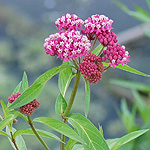
Common Name
Swamp Milkweed
Scientific Name
Asclepias incarnata L.
Plant Family
Dogbane (Apocynaceae)
Garden Location
Woodland - Marsh
Prime Season
Early Summer to Late Summer Flowering
Swamp Milkweed is an erect native perennial that can reach to six feet in height with divided branches toward the top in the inflorescence. Stems are green, circular and without hair. Like most milkweeds, they contain a milky juice which is toxic.
Leaves are lance like with pointed tips, stalkless to clasping, up to 3 inches long, opposite and with smooth margins and smooth medium to dark green surfaces.
The Inflorescence consists of branching stems in the upper 1/3 to 1/2 of the plant, with erect umbels of flowers at the tips of those branches. Each umbel contains numerous flowers.
The striking flowers in the Milkweed family, when open, have five erect hood-like nectaries with the petal parts bent downward. These vary in color in this species from flesh-pink to rosy-purple, but the hoods are a lighter shade. The hoods each have a small horn on the inner side that curves inward and in this species is much taller than the hood. Each flower is about 3/8 inch tall and 1/4 inch wide. Eloise Butler explains the function of these parts in her notes below.
The pollination system of Milkweeds works like this: The pollen of the milkweed is not in the form of free grains attached to an anther, but is contained in a waxy sac called a "pollinium" [plural - pollinia] with each sac having about a few hundred grains. Each Milkweed flower has two ovaries connected to the five flower parts, each part has a very short pistil with an enlarged stigma which has the form of a deep slit. Pollina sacs are in pairs with one sac located on each side of the stigma and each of the pair of sacs is connected by a 'translator arm' to a structure called a 'corpusculum' which sits atop the stigma slit. There is a groove in the corpusculum and the foot of an insect, such as a bee or butterfly, gets caught in the groove and when the foot is pulled out, the pair of sacs and the associated structure comes along with the foot and thus are then carried from flower to flower by the insects resulting in pollination. Any insect large enough and strong enough to remove the sac can fertilize another plant.
The method of fertilization is also interesting. Once a corpusculum has been pulled out, after a few minutes, the translator arms rotate the pulled out sacs 90 degrees. After the rotation when the insect reaches another flower, the sac is now in position to fit into the bottom of the slit in the stigma. As the insect moves its foot the sac is pulled upward in the slit until it hits the still existing corpusculum of that flower. At that point the translator arm snaps off and the pollen sac is in position to fertilize the flower. When the corpusculum of that flower is still present it is possible for the insects foot to catch it and thus remove another pair of pollen sacs for another go at the next flower. When the corpusculum of a flower has already been removed the chances of the translator arm breaking off are reduced and the pollina sac may not be broken off and is carried away by the insect to another plant.
Thus those flowers with their corpusculum still in place have the greatest chance of being fertilized. This is why the numerous flowers result in only a few seed pods. The fact that the translator arms take a few minutes to rotate after being pulled from a flower prevents the insect from cross pollinating adjacent flowers and allows the insect to find other plants that may not be clones of the first plant the insect visited. [This summary is based on the research work of Douglass H. Morse of Brown University.]
Seeds: Fertile flowers develop a slender green pod (a follicle) held erect on erect stalks. The pod turns brown at maturity and contains a large number of flat brown seeds attached to long white silky hairs. When the pod splits, these are dispersed by wind. In shape, seeds resemble a pumpkin seed. Seeds require 30 days of cold stratification for germination.
Habitat: Swamp Milkweed is a common plant of bogs, swamps and wet places, with full sun. It grows from a rhizomatous root system and adapts to loamy, sandy or clay soils but does not tolerate well dry conditions.
Names: The Angiosperm Phylogeny Group in 2000 re-assigned the Ascelepias genus to the Apocynaceae family from the previous Asclepiadaceae (Milkweed) family. The genus name, Asclepias, is for the Greek god of healing. The species name, incarnata, is Latin for flesh, which may refer to the color of the flowers at certain times. The author name for the plant classification, 'L.' refers to Carl Linnaeus (1707-1778), Swedish botanist and the developer of the binomial nomenclature of modern taxonomy.
Comparisons: The showy erect pinkish umbels of flowers and the branching at the top of the plant will readily identify this species of milkweed. Most of the other species with pinkish flowers have the umbels nodding. See in 'notes' below links to other species of Milkweed.


Above: The inflorescence consists of branching stems in the upper 1/3 to 1/2 of the plant, with erect umbels of flowers at the tips of those branches. Drawing from Britton, N.L., and A. Brown. 1913. An illustrated flora of the northern United States, Canada and the British Possessions. 3 vols. Charles Scribner's Sons, New York.
Below: Flowers, when open, have five erect hood-like nectaries with the petal parts bent downward. These vary in color in this species from flesh-pink to rosy-purple, but the hoods are a lighter shade. The hoods each have a small horn on the inner side that curves inward and in this species is much taller than the hood.
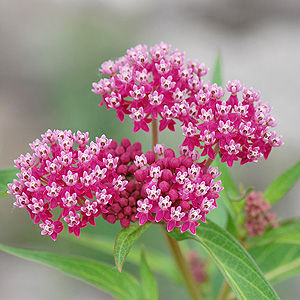
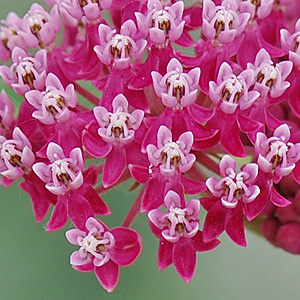
Below: Leaves are narrow and pointed. Lower leaves will typically have a short stalk as shown.

Below: 1st photo - Seed pods form in an upright position. 2nd photo - Seeds emerging from the pod and taking to the air.

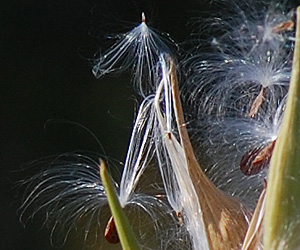
Below: 1st photo - The seed pods beginning to open in mid-September, 21 days after the photo of the green pods above. Note the way the seeds are at the bottom of the pod and the silky hair of each seed is attached to the top of the pod. 2nd photo - The milky latex found in the stems.


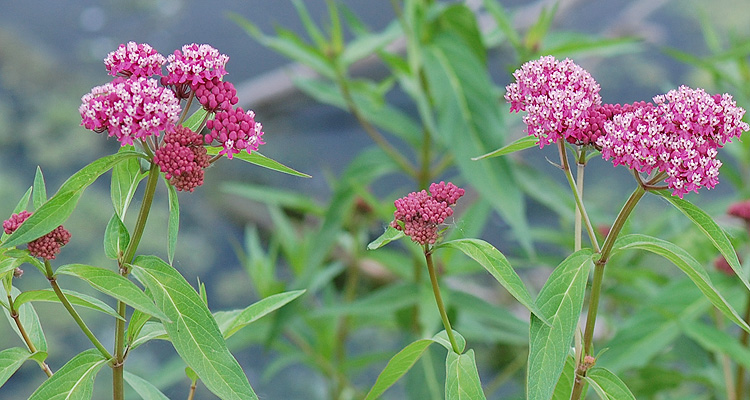
Robert Frost wrote a poem about milkweed and Monarch Butterflies. Read it here: "Pod of the Milkweed"
Notes: Swamp Milkweed is indigenous to the Garden area. Eloise Butler catalogued it on May 31, 1907. She also planted it in 1918. Martha Crone planted it in 1946 and Cary George planted more in 1993. It is native to most counties in Minnesota except a scattered few in the central part of the state. Likewise in North America it is found throughout except the extreme west.
There are 14 species of Milkweed native to Minnesota. Five of these are found in the Garden: A. exaltata, Poke Milkweed; A. incarnata, Swamp Milkweed; A. syrica, Common Milkweed; A. tuberosa, Butterfly Weed; and A. verticillata, Whorled Milkweed.
Eloise Butler wrote this about Milkweeds: "Most of the milkweeds, as the term implies, are furnished with a copious, milky juice. Crawling insects are likely to be covered and impaled by this sticky fluid, which exudes from wounds made by their sharp claws, as they scale the stems of the plants, and thus prevents them from rifling the nectar provided by the flowers for the pollen-distributing, hairy-bodied flying insects. Wonderful are the adaptations of the flower to desirable insect guests. Above the petals is a crown of five hood-like nectaries, each bearing within a slender, inverted horn. The center of the flower is designedly slippery. When an insect alights on this slimy surface to sip the abundant nectar, her feet slip and are tightly caught in crevices, also of fell design. When she extricates her toes, so to speak, she drags out attached to them a dangling pair of pollen masses - pollinia, a part of which is sure to adhere to the pistil of the next milkweed flower she visits. Insects have been caught at this season with stalks of these pollinia attached to every one of their six feet." Published in the Minneapolis Sunday Tribune. July 9, 1911
Toxicity: The leaves, stem and root contain toxic elements; cattle are particularly susceptible to hemorrhages of the heart, lung and gastrointestinal tract when the plant is eaten either in the field or as part of a fed ration. Toxins include a cardiac glycoside, asclepiadin, and resinoids and a few alkaloids.
Lore and Uses: Swamp Milkweed has a medicinal history, having been listed in both the NF (National Formulary) and the USP (United States Pharmacopoeia). The root is the active part containing volatile oil, albumen, starch, pectin, 2 acrid resins, an alkaloid, and the glucoside asclepiadin (the emetic principle). The root is a rhizome, 1 inch in diameter, yellow-brown with a white interior. Densmore (Ref#5) reports on the use by the Chippewa as an anthelmintic (for parasite infections), cathartic (as a purgative), and emetic (to induce vomiting). One detailed description in her writings was the use of the root to prepare a bath. The whole root was steeped in one quart of water, then strained, and when cooled bathe a child in it who was fretful or needed strengthening. The bath water was also used for older people when they were sick or tired. Mrs. Grieve (Ref#7) reports that it strengthens the heart in the same manner as digitalis and that it is also a certain diuretic. An infusion was prepared with 1/2 oz. of powdered root to a pint of boiling water.
Return to -- Site Plan/Archive Index --or-- List of Common Plant Names -- or -- List of Scientific Names -- or --Home Page - - - Back to top.
References: Plant characteristics are generally from sources 1A, 32, W2, W3, W7 & W8 plus others as specifically applied. Distribution principally from W1, W2 and 28C. Planting history generally from 1, 4 & 4a. Other sources by specific reference. See Reference List for details.
 Identification booklet for most of the flowering forbs and small flowering shrubs of the Eloise Butler Wildflower Garden. Details Here.
Identification booklet for most of the flowering forbs and small flowering shrubs of the Eloise Butler Wildflower Garden. Details Here.
©2013
Friends of the Wildflower Garden, Inc. Text and photos are by G. D. Bebeau unless otherwise credited. "www.friendsofeloisebutler.org"
042220